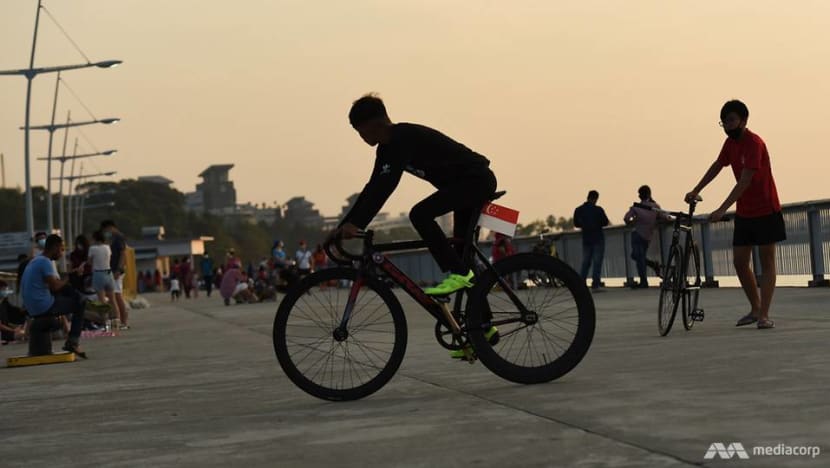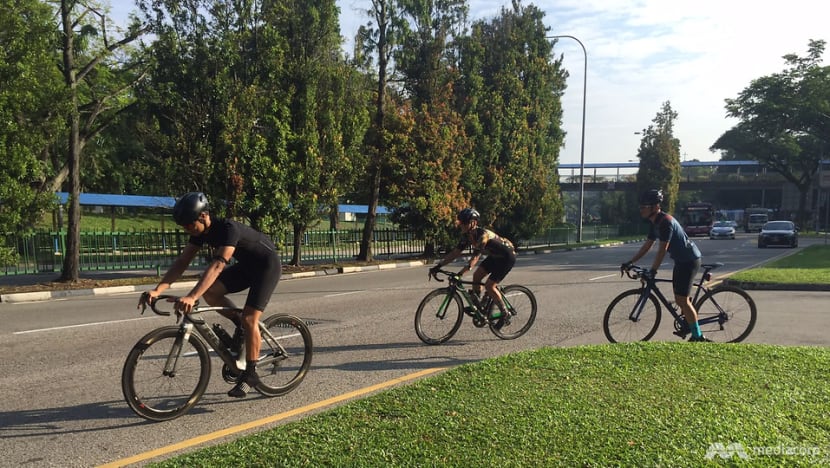commentary Commentary
Commentary: Errant cycling gives the rest of us cyclists a bad name
Singapore’s cycling journey has had ups and downs but instead of calling for more regulation, we could all stand to exercise more graciousness, says Jeremy Nguee.

Cyclists along a Park Connector in Singapore.
SINGAPORE: It was that week after Christmas in 2020.
The air was a nippy 23 degrees Celsius and there was even a chilly snap. A low mist had risen over the grass, and the roads were moistened black with the torrential rain, without a chance to dry.
The sunrise was surreal on those mornings, filtering through old trees, reflecting on the still puddles and enveloping the buildings in a transparent sheet of gold.
I had been riding for six consecutive days by then, clocking over 500km. I was a little sore but wasn’t going to pass up the opportunity to experience the magic again.
Like many Singaporeans, I haven’t had the chance to travel in 2020. To enjoy this cool weather and beautiful scenery right here at home in Singapore felt like I was discovering a new city.

READ: Commentary: Cycling great for going green but is still a pain in urban Singapore
A multitude of cyclists must have thought the same that day, pouring out into the streets and park connectors, joining joggers and hikers to enjoy the cool morning air.
THE GOOD: THE EXPLOSION IN CYCLING ENTHUSIASTS
COVID-19 and the subsequent lockdowns have catalysed an explosion in the number of people who have embraced jogging, cycling or simply enjoying the outdoors around the world.
We have found new ways to manage our mental health, connect with our families, and become more conscious about sustainable ways of living.
For cities globally, this has renewed interest in the environment and in creating safer ways of travelling.
Cycling, whether as a form of commute or recreation, has been touted as the answer. It has numerous additional benefits in community building and keeping the general population healthy and active.
THE BAD: HIGH-PROFILE ACCIDENTS FUELLINGS CALLS FOR TOUGHER REGULATIONS
Yet recently, a number of incidents caused by cyclists has raised the old debate of whether cyclists should be allowed on the road and if more limits should be imposed given that they can be a hindrance and cause of accidents.
Tales of enforcement officers fining a group of more than 30 errant cyclists over one weekend come to mind too.
The Government has been faced with calls to regulate their use. A panel will now review regulations for cyclists on the road and study if tests and licenses should be required, Senior Minister of State for Transport Chee Hong Tat said in April. But is that really the best way to go?
There is no excuse for lawless behaviour and errant cyclists should be taken to tasks. Here is where higher penalties for reckless riding harming others raised just last October are welcomed. Perpetrators are looking at a potential jail term not just a fine.
Yet when people ask if cyclists should be licensed, I wonder if the comparison with cars and powered bikes is a fair one, where errant and negligent drivers behind the wheel of powerful vehicles can cause more harm. Are government resources not better spent elsewhere?
Speed surely cannot be the issue if sport car drivers aren’t treated differently from the average car driver.
READ: Commentary: The year e-scooters were kicked off footpaths
READ: Commentary: The PMD problem in Singapore is not just about jostling for space
THE NICE: CYCLING GROUPS
Like everyone who follows the rules and tries to keep the peace, I too am annoyed by cyclists who change lanes without consideration, or run double white lines.
The errant cyclist does not represent the community in the same way a bad driver does not represent all drivers. So let’s not demonise cyclists
There are numerous cycling interest groups promoting responsible cycling that better represent the good intentions and law-abiding nature of cyclists in Singapore: Brompton Singapore organises group rides for owners of the iconic folding bicycle, while Women’s Cycling Project gets together women cyclers.
There are also groups by geography, whether Eastcyclopedia for riders in the East or West Coast Riders.
Within this tight-knit community, we are responsible road users who do our best to help new riders familiarise themselves with road conditions, and encourage them to learn the laws and apply them well. We know deviating risks our own safety.

During each outing, ride leaders take care of their pack. They provide a safety briefing. They set expectations that traffic rules will be adhered to, including stopping at all red lights without exception.
Leaders also take pains to go over essential etiquette riders should display, in signalling to change lanes, checking back and calling out obstacles.
They also teach techniques to deal with practical situations, such as how to ride two-abreast on roads without obstructing traffic, and how to change to single-file on two-way, single-lane carriage roads to allow cars to pass in a safe manner.
READ: Commentary: Banning bicycles from footpaths won’t make poor cycling habits disappear
As an extension of the social nature of cycling groups, a number also organise charity drives to give back to society.
Before the circuit breaker last year, Brompton Riders had an annual ride to pack and distribute care packs on their bikes to the needy, while Rapha Cycling Club organised a ride in September 2020 to send coffee care packs sponsored by PPP Coffee to nominated essential worker heroes.
THE HOPE: A GRACIOUS SOCIETY
If you are a new cyclist planning on using the road, my advice is you acquaint yourself with the laws on road use. Better yet, get in touch with the many cycling groups in Singapore either out of the local bike shops or online groups.

Fellow cyclists will be happy to help you, but we will also not hesitate to tell you off if you run afoul of the law. We are tough on our own because we know deep down inside, solving errant cycling will require weeding out the bad guys.
But we could sure use more cooperation from all road users. For one, car drivers and other motorists could be more patient with cyclists as they are with trucks, buses and other slow-moving vehicles.
They should also be familiar with the Road Traffic Act and adhere to the rules so as not to endanger cyclists: Stop at stop lines, give way at give way lines, and not be tempted to go above the speed limit just because no one is looking.
Our authorities also have much to do to transform our country into one that embraces the future, and this action starts now. Young people should be engaged about safe public path use.
READ: Commentary: Bike lanes and housing in the CBD? Here’s how COVID-19 could transform cities
Changes in road features should come with public announcements. A public education campaign will clarify how motorists should drive in relation to cyclists and affirm how cyclists should ride on the road.
THE FUTURE: WITH CYCLING A BIG PART
Everyone has a part to play in using shared spaces. We have an opportunity to shape a new normal when it comes to cycling. Will we embrace a kinder, more graceful society?
A Singapore where we can trust drivers, motorists, cyclists to ensure our children get to school safely, where we can take for granted our elderly will come home safely after an evening walk? Or do we need regulation to help us be better road users?
On a human level, each time we read of an accident involving a car driver and his passengers, a rider and the pillion, or cyclists, our hearts ache because it involved one of our own - someone’s dad, somebody’s mother, or a schoolmate.
I hope the news of errant cyclists does not discourage you. I hope you will come and discover this amazing phenomenon and be part of Singapore’s wonderful cycling community.
You might just discover a new side to Singapore, and fall in love with life all over again.
Jeremy Nguee is chef-owner of Dream Shop, Batu Lesung Spice Company and MRS KUEH and a ride leader with Rapha Cycling Club.















